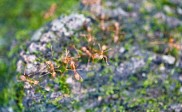8 Helpful Considerations for Wildlife Photography
Wildlife Photography
Taking photographs of wildlife is a very rewarding experience. However, gaining the necessary skills in order to capture great wildlife photos is a bit more difficult than it may seem. Several elements should be taken into consideration in shooting excellent nature and wildlife compositions. It needs some experiment, practice and patience to gain the expertise for shooting wildlife.
Most wildlife photography is extremely spontaneous. You need your camera to be always handy and ready for the unexpected. Here are 8 helpful considerations for wildlife photography:
1.) Wildlife Photography EQUIPMENT
A factor that should be taken into deep consideration while performing any kind of photography specifically wildlife, is your equipment. Wildlife photography can be very time-consuming and unpredictable. Thus, having the right equipment and be well prepared is essential. Your equipment needs to be ready on anything that may be presented to you, so you should know first, what you’re trying to capture. If you’re going to take pictures of birds for instance, you’ll need access to a telephoto lens to be able to capture them from a distance but still you won’t be able to get a close-up detailed photograph. It is very important if you’re going to take photos of a larger animal, you’ll need a short lens. Tripods are a very handy tool in this setting as well and more beneficiary are lightweight tripods for ease of traveling. You also need to pay attention to your attire. You need to be able to blend in but also be prepared for what the weather may bring. If it’s snowing, you’ll need warm clothes for a long period of time. Additionally, extra batteries are a very good idea.

Photo by ScorpionEntity
2.) PATIENCE
As a wildlife photographer, you need to know that you will never have an idea of what to expect nor how long it will take to get anything worth shooting. Many wildlife photographers begin their day before sunrise and don’t give up until after sunset. The “patience is a virtue” factor is extremely important to use if you want to be successful in this field. There are many times when wildlife photographers will spend a whole day and get absolutely nothing but this shouldn’t stop you from trying again the next day.

Photo by law_keven
3.) RESPECT
Respect is another essential element to consider as you are dealing with wildlife. These animals are dangerous, unpredictable and WILD! You need to know when to back off and how to handle a situation when you’ll be face to face with a giant bear. Even more beneficial, is creating a spot where you’re never seen, whether it’s in a tree, behind a bush, and so on. Just remember, whatever you do, don’t pester the animals. You are in their territory.
4.) COMPOSITION
When you’re taking wildlife photographs, just like all other photography fields your composition is very important as well as your awareness of your environment. You need to consider the surroundings, both in your photo and outside of the frame. Other considerations are your height, as most humans are taller than the animals they are shooting so, getting your pants dirty is highly likely. You should also consider your angle, the space around the animal and what they are doing in the frame. Being sure you can capture the animal in its entire setting is very important. A good guideline for this is the Rule of Thirds in photography.
5.) LIGHTING
Lighting, like composition is essential to any field of photography. However in wildlife photography, if you don’t have an understanding of lighting it could hurt you because of the spontaneity of this field . Having a good grasp on the lighting that your setting is in and keeping up with how it changes through the day is critical. Most wildlife photographers do carry an external flash with them for unexpected lighting issues.
6.) BACKGROUND
Background may also fall in line with composition but it doesn’t hurt to address this by itself. Whenever you come to the area in which you plan to take photos, it is by no means your permanent location. You’re most likely, going to be moving around so, having a firm understanding of the background you are shooting is imperative. On the other hand, since you’re moving around, you need to have the ability to adapt and do so quickly. Make sure you aren’t setting up a shop in a cluttered area because you don’t want other elements to minimize the effects of your subject.

Photo by Alan B
7.) FOCUS
Along with your lens, flash, lighting, composition, etc. focusing is a prime element if you want a successful wildlife shot. A captivating wildlife photograph involves capturing your subject’s eyes with extreme sharpness and focus. Even more, if you can prefect the focusing of the animal’s eyes, an expert wildlife photographer will try to capture an animal with their eyes illuminating with light. Commonly, this is referred to as “catch-light.”

Photo by Andrea Westmoreland
8.) CLOSE UPS
Something that photographers struggle with over time, is the ability to capture animals at a close distance. With birds and smaller animals, using a telephoto lens as mentioned previously is essential. However, trying to capture a larger animal at a close proximity proves to be quite difficult. You may want to keep your distance and practice capturing animals with a large lens as many animals will react negatively if approached. There are many methods or suggestions that you can try but more importantly is just having the patience to wait until it comes out.
Hopefully you’ll find a few, if not all of these suggestions helpful in your wildlife photography journey. It is by no means the end of the list but they are all beneficial if you’re trying to capture wildlife. Furthermore, the best way to capture wildlife is practice. Any photographer will tell you that the best way to achieve the photographs you want is by practice and experiment.
Top photo by maschiworld
If you liked this article about wildlife photography, don’t forget to add a comment in the section below.




I love wildlife photography but it is so difficult to me, I wish I can make some good wildlife photos like these! thanks for the tips!!!!!!!
Hey Jack… just a little practice and patience will give you a great start! Good luck and thank you for the comment!! 🙂
yes sarah u r totally right and i do agree with u. but i need to add something with your tips are 1. one should understand his/her equipment very well so he/she can change the lens or setting fast to frame the image. 2. one should never use any sort of cosmetics or deodorants/perfumes while u r on a shoot.3. he/she should carry a raincoat for his/her camera and lens.
That fox is gorgeous. I wish I could feature animals. I might one day expand my site for that but for now I am just people… Wow thou.
You are right in making ‘patience’ a point. In wild life photography if you can be quiet and be still, the subjects will have chances to come close to you.
Sarah, what do you think about AF-S zoom-Nikkor 70-300mm f/4.5/5.6 G IF-ED on using in wildlife photograpy?
Do you have any experience with it or other Photographers commentaries about that lens?
Thanks.
Natan.
Wildlife photography is my absolute favorite. it’s so beautiful, and I love seeing the details of the animals. I like what you said about focusing on the right aspect of the picture, to make it a “successful” shot. The photograph of the fox is probably my favorite.